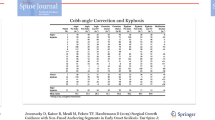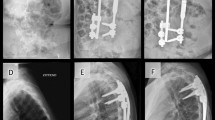Abstract
Questions/purposes
Adolescent idiopathic scoliosis is a 3D spine deformity that worsens during the whole growth. New methods for spinal growth modulation with flexible spinal implants have been described to avoid progression of the deformity during growth spurt. The main limitations are that no specific ancillaries and devices are available, which makes the surgery technically demanding.
Methods
We have developed a new method of spinal growth tethering using minimal invasive videothoracoscopic approach. Fixation is performed with staples and synthetic ligament on the lateral aspect of vertebral bodies on main curvature convexity. Patients with progressive thoracic idiopathic scoliosis despite the brace treatment were included. The clinical and radiological examinations were compared before and 2 years after surgery.
Results
Six patients with flexible thoracic curves with a mean age 11.2 ± 1.2 years and a mean Cobb angle 45° ± 10° (35–60) were operated. All were skeletally immature. At last follow-up, the Cobb angle was stable. None of the patient underwent fusion.
Conclusions
The procedure allowed a stabilization of the deformity during growth spurt. Validated devices and further studies with longer term follow-up are needed to confirm the efficiency of this technique. This small cohort of patients is a source of reflection for further medical devices developments.
Level of Evidence
Level 4 case series comparing to not randomized studies.





Similar content being viewed by others
References
Courvoisier A, Drevelle X, Vialle R, Dubousset J, Skalli W (2013) 3D analysis of brace treatment in idiopathic scoliosis. Eur Spine J 22:2449–2455
Nachemson AL, Peterson LE (1995) Effectiveness of treatment with a brace in girls who have adolescent idiopathic scoliosis. A prospective, controlled study based on data from the Brace Study of the Scoliosis Research Society. J Bone Joint Surg Am 77:815–822
Charles YP, Daures JP, de Rosa V, Diméglio A (2006) Progression risk of idiopathic juvenile scoliosis during pubertal growth. Spine (Phila Pa 1976) 31:1933–1942
Samdani AF, Ames RJ, Kimball JS, Pahys JM, Grewal H, Pelletier GJ, Betz RR (2015) Anterior vertebral body tethering for immature adolescent idiopathic scoliosis: one-year results on the first 32 patients. Eur Spine J 24:1533–1539
Samdani AF, Ames RJ, Kimball JS, Pahys JM, Grewal H, Pelletier GJ, Betz RR (2014) Anterior vertebral body tethering for idiopathic scoliosis: two-year results. Spine (Phila Pa 1976) 39:1688–1693
Crawford CH 3rd, Lenke LG (2010) Growth modulation by means of anterior tethering resulting in progressive correction of juvenile idiopathic scoliosis: a case report. J Bone Joint Surg Am 92:202–209
Courvoisier A, Eid A, Bourgeois E, Griffet J (2015) Growth tethering devices for idiopathic scoliosis. Expert Rev Med Devices 12:449–456
Lenke LG (2003) Anterior endoscopic discectomy and fusion for adolescent idiopathic scoliosis. Spine (Phila Pa 1976) 28:S36–S43
Pompeo E, Mancini F, Ippolito E, Mineo TC (2010) Videothoracoscopic approach to the spine in idiopathic scoliosis. Thorac Surg Clin 20:311–321
Weinstein SL, Dolan LA, Wright JG et al (2013) Effects of bracing in adolescents with idiopathic scoliosis. N England J Med 369:1512–1521
Green DW, Lawhorne TW, Widmann RF et al (2003) Long-term magnetic resonance imaging follow-up demonstrates minimal transitional level lumbar disc degeneration after posterior spine fusion for adolescent idiopathic scoliosis. Spine (Phila Pa 1976) 28:2078–2085
Betz RR, Kim J, D'Andrea LP, Mulcahey MJ, Balsara RK, Clements DH (2003) An innovative technique of vertebral body stapling for the treatment of patients with adolescent idiopathic scoliosis: a feasibility, safety, and utility study. Spine (Phila Pa 1976) 28:S255–S265
Betz RR, Ranade A, Samdani AF, Chafetz R, D'Andrea LP, Gaughan JP, Asghar J, Grewal H, Mulcahey MJ (2010) Vertebral body stapling: a fusionless treatment option for a growing child with moderate idiopathic scoliosis. Spine (Phila Pa 1976) 35:169–176
Theologis AA, Cahill P, Auriemma M, Betz R, Diab M (2013) Vertebral body stapling in children younger than 10 years with idiopathic scoliosis with curve magnitude of 30° to 39°. Spine (Phila Pa 1976) 38:1583–1588
O'leary PT, Sturm PF, Hammerberg KW, Lubicky JP, Mardjetko SM (2011) Convex hemiepiphysiodesis: the limits of vertebral stapling. Spine (Phila Pa 1976) 36:1579–1583
Courvoisier A (2016) The future of academic innovation in the field of medical devices: is innovation still possible in orthopedics? Expert Rev Med Devices 13:807–813
Author information
Authors and Affiliations
Corresponding author
Ethics declarations
Conflict of interest
The authors declare that they have no conflicts of interest concerning this article.
Electronic supplementary material
ESM 1
(PDF 798 kb)
Rights and permissions
About this article
Cite this article
Boudissa, M., Eid, A., Bourgeois, E. et al. Early outcomes of spinal growth tethering for idiopathic scoliosis with a novel device: a prospective study with 2 years of follow-up. Childs Nerv Syst 33, 813–818 (2017). https://doi.org/10.1007/s00381-017-3367-4
Received:
Accepted:
Published:
Issue Date:
DOI: https://doi.org/10.1007/s00381-017-3367-4




